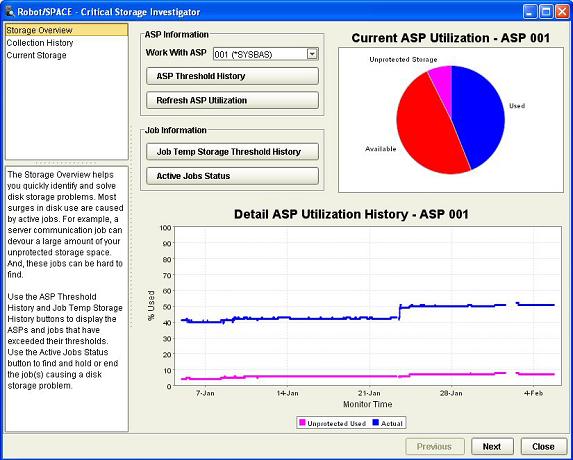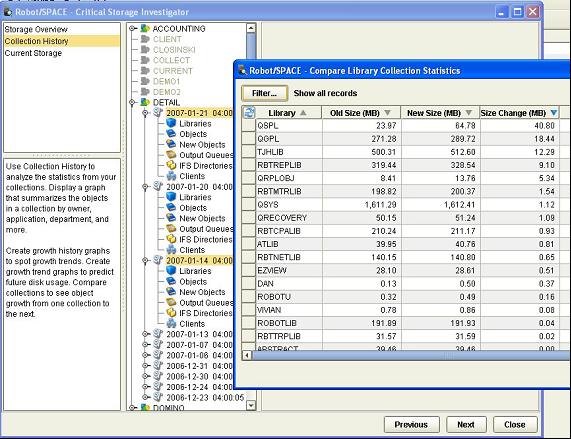What happened to all our disk space? Why did our IFS space grow? I need more space to test this? When are we getting more space?
Where in the system administrator's job description does it say, "Endure constant harassment regarding disk space issues"? It's not there, but that doesn't stop the questions.
Part of the frustration for users and for those of us in the IT department lies in not having an answer...or a good solution. Managing disk space is a difficult job. It's expensive, and there never seems to be enough space to satisfy everybody.
So, when our disk space is nearly full, we have to sweat it out with the same old routine. We run our utilities and wait several hours for them to begin to identify system growth. We dash off a stern email instructing staff to clean up their libraries and IFS directories ASAP. And we manually delete some of the usual suspects—job logs, spooled files, SAVF files, and journal receivers—and say to ourselves, "I hope nobody needs this...or this...and all of these."
Managing and monitoring disk space doesn't have to be a mystery. And it doesn't have to be a laborious waste of time. Robot/SPACE completely eliminates disk storage crises and monitors your disk storage so you don't have to.
With Robot/SPACE, the next time your disk storage is getting full, you are the first one to know. When an ASP reaches a storage, growth, or unprotected storage threshold you define, Robot/SPACE fires off a message to a message queue. Robot/SPACE also can use Robot/ALERT, Help/Systems' event notification software, to send text, email, or pager messages to any device.
After the notification, you simply launch the Critical Storage Investigator (CSI), which is the only tool you need to quickly find and correct a storage problem. The CSI graphically displays your current ASP utilization and ASP utilization history in real time, as shown in Figure 1.

Figure 1: You can see ASP utilization at a glance. (Click images to enlarge.)
Frequently, a runaway job consuming a large amount of temporary storage will drive up your unprotected storage used, and you'll see a noticeable spike on the graph. From the CSI, you can display the current size of all your jobs (and their predefined thresholds) and then hold or end the out-of-control job. Runaway jobs account for the majority of mysterious storage issues, but only Robot/SPACE monitors job temporary storage and lets you isolate out-of-control jobs.
If the ASP utilization history graph shows a spike in permanent storage utilization, use the CSI to pinpoint the date of the rapid growth and compare two storage collections for the ASP in question: one from before the increase and one from after it. The comparison lists all the libraries or objects that have grown between the collections. You then know exactly which objects have grown abnormally and can check them out—without wasting time or deleting objects your users may need. (See Figure 2.)
Figure 2: You can display the size of every object in a storage collection and compare collections to determine object growth.
If the ASP utilization graphs show normal growth, you can use the CSI to run the System Health Report to examine growth at the system level. This report identifies your largest libraries, objects, and directories. Use this simple report to find the source of the problem fast.
Robot/SPACE also allows you to graphically summarize collection statistics by size and sort them any way you want. And, using Robot/SPACE, you can create and run storage audits that perform over 20 cleanup tasks automatically, keeping your disk use to a minimum.
Robot/SPACE lets you choose how to monitor your disk space usage and gives you the tools and information to find problems quickly and to effectively plan for the future. This makes you a star with your users and with management at equipment budget time. And you're a star at home, too; you're no longer spending long hours at the office trying to figure out what's eating up all your disk space.
You can learn more about Robot/SPACE by clicking here. And check out Help/Systems' other offerings in the MC Showcase Buyer's Guide.
Tom Huntington is Vice President of Technical Services for Help/Systems, Inc. He can be reached at 952.563.1606 or













 Business users want new applications now. Market and regulatory pressures require faster application updates and delivery into production. Your IBM i developers may be approaching retirement, and you see no sure way to fill their positions with experienced developers. In addition, you may be caught between maintaining your existing applications and the uncertainty of moving to something new.
Business users want new applications now. Market and regulatory pressures require faster application updates and delivery into production. Your IBM i developers may be approaching retirement, and you see no sure way to fill their positions with experienced developers. In addition, you may be caught between maintaining your existing applications and the uncertainty of moving to something new. IT managers hoping to find new IBM i talent are discovering that the pool of experienced RPG programmers and operators or administrators with intimate knowledge of the operating system and the applications that run on it is small. This begs the question: How will you manage the platform that supports such a big part of your business? This guide offers strategies and software suggestions to help you plan IT staffing and resources and smooth the transition after your AS/400 talent retires. Read on to learn:
IT managers hoping to find new IBM i talent are discovering that the pool of experienced RPG programmers and operators or administrators with intimate knowledge of the operating system and the applications that run on it is small. This begs the question: How will you manage the platform that supports such a big part of your business? This guide offers strategies and software suggestions to help you plan IT staffing and resources and smooth the transition after your AS/400 talent retires. Read on to learn:
LATEST COMMENTS
MC Press Online